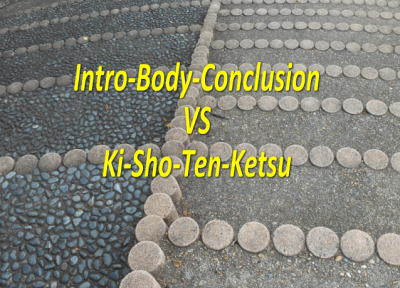Differences Between English and Japanese
Japanese Ki-Sho-Ten-Ketsu Format
 That's How 4-Cell Manga Begins and Ends That's How 4-Cell Manga Begins and Ends
 Traditional Japanese Yon Koma Manga (四コマ漫画) or 4-cell manga is one of the most conspicuous examples of Ki-Sho-Ten-Ketsu structures.
Traditional Japanese Yon Koma Manga (四コマ漫画) or 4-cell manga is one of the most conspicuous examples of Ki-Sho-Ten-Ketsu structures.
Each of the four cells represents each phase of the format. The first cell serves as Ki (Start), setting a scene or premise for the story, and the second, Sho (Unfold), developing it. Then, the third is Ten (Turn/Change), where the story has a sudden change or reaches the climax, while the fourth cell is Ketsu (Close), the conclusion (often the punchline) in comical pieces.
Originated from Chinese-style poem structure, this Ki-Sho-Ten-Ketsu format may be well-fitting to 4-cell manga or other narrative works. However, it’s a bit bizarre if the idea becomes a significant part of the writing curriculum at school. Well, that’s what happens in Japan.
I hope things at school are changing, but many children can grow up believing that the format is the only way to produce a writing piece. As a result, they start their business letters by saying “Thank you for your daily patronage” (even if the recipients have not yet bought anything) or “We are happy that your business continues to prosper” (despite that they don’t know or care whether or not). They do that as if they could set up a scene to start communication.
In other cases, they may insert portions that are not logically relevant to the topic or reserve the critical message (conclusion) like dessert.
It may be too quick to connect Japanese reluctance to forgo trivial greetings and reveal the conclusion at the beginning with Ki-Sho-Ten-Ketsu. But, things learned at an early stage of life may persist and may affect people’s ways of thinking. Why not?
 Ki-Sho-Ten-Ketsu in Science or Business? Ki-Sho-Ten-Ketsu in Science or Business?
Then, don’t Japanese people ever learn other structures than Ki-Sho-Ten-Ketsu? Yes, they do. But usually not until they have to write an academic report or graduation thesis at university. Or later at work, when they have to submit a written proposal or create a compelling presentation deck. Thus, they encounter a new format where the conclusion must come first, and the entire writing should follow sound logic.
Therefore, the Introduction-Body-Conclusion structure prevails at the academic, scientific, and business scenes, particularly involving the production of scientific reports, papers, technical documents, and other professional writing pieces. The following shows a rough list of projects using the Ki-Sho-Ten-Ketsu format:
- Non-scientific essays and reports
- Business letters
- Ceremonial speeches
- Stories and poems

A wildflower field spreading itself
|



